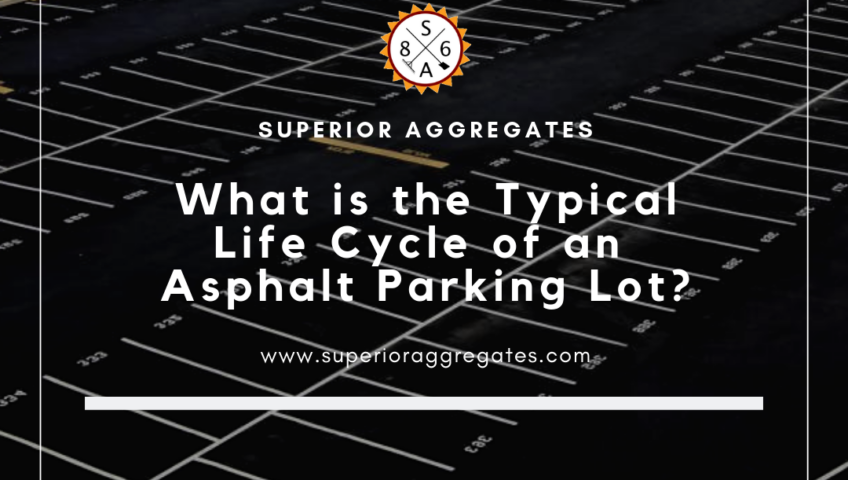
What is the Typical Life Cycle of an Asphalt Parking Lot?
No matter how sturdily a structure is laid, it will eventually reach a time when it will require maintenance or replacement. The period it takes before reaching such an instant defines a structure’s lifecycle. Asphalt parking is one such structure, and if you own one, then you need to keep updated on essential aspects that define its lifecycle.
Various factors affect the lifecycle of an Asphalt parking lot. Environmental conditions, design and construction elements, water drainage means, frequency of maintenance, and significant of all, traffic load, are some of the critical aspects to the lifecycle of an Asphalt parking lot.
In this article, we shall focus specifically on the lifecycle of an asphalt parking lot as well as factors signifying a need for maintenance or replacement.
Asphalt Parking Lot’s Life Cycle
In overall, a standard asphalt parking lot can last for up to 25 years. However, this period can reduce or increase depending on asphalt maintenance regularity. But what happens during this lasting period?
Well, let’s have a look.
0 to 5 years: For the first five years since construction, your asphalt parking is still strong and probably shows little or no signs of damage. If anything, the surface might have insignificantly deformed while color discoloration might be visible, especially if it is extensively exposed to sunlight.
5 to 7 years: During this period, your parking lot starts experiencing minor cracks, thereby necessitating for maintenance services. Practices such as crack-sealing and seal-coating are necessary at this stage.
7 to 15 years: With proper maintenance practices during the previous phase, your parking might not undergo significant damages for the next 15 years. However, you should continually check for damages while ensuring necessary maintenance practices for prolonged endurance.
15 to 25 years: After 15 years of use, you should expect your Asphalt parking lot to have started developing visible cracks as well as considerable deformation. If such damages are significant, you might need to resurface your parking lot.
Over 25 years: beyond 25 years signifies the end of the parking’s life cycle. During this stage, it has undergone extensive damages and probably multiple repairs, which means it might no longer withhold the weight of your vehicle. If more repairs seem to be of no help, then you can reconstruct the entire structure.
Maintenance Practices Timing
Maintenance involves various activities including crack-sealing, seal-coating, and resurfacing, all which should be timely carried out. But how do you determine the best time for every maintenance practice?
Crack Sealing
Filling of small cracks in your parking lot should be done using a liquid concrete filler. Cracks to seal should be small, not exceeding half an inch in terms of width. You should schedule a crack sealing exercise every year to extend the lifecycle of your asphalt parking.
Seal coating
As one of the concrete maintenance activities, seal coating is meant to reduce concrete exposure from the effects of sunlight, spillages, water, and air oxidizers. Seal coating should be best carried out immediately after the crack sealing process or any other time beyond six months when damages start revealing.
Resurfacing
Extensive damages might eventually necessitate for resurfacing process. It involves adding a new asphalt layer on top of the existing one, a process also referred to as overlaying. This process should only happen after a decade of parking construction. You should also initiate it during favorable weather conditions, preferably during warm seasons.
Final Thoughts
Since timely maintenance is essential for your asphalt parking lot, you need to be observant on the emergence of an issue. If conditions such as cracks are unattended to, they may continually weaken the surface leading to a reduced timeline. Moreover, you should act on any issue you identify as soon as possible.
No matter how sturdily a structure is laid, it will eventually reach a time when it will require maintenance or replacement. The period it takes before reaching such an instant defines a structure’s lifecycle. Asphalt parking is one such structure, and if you own one, then you need to keep updated on essential aspects that define its lifecycle.
Various factors affect the lifecycle of an Asphalt parking lot. Environmental conditions, design and construction elements, water drainage means, frequency of maintenance, and significant of all, traffic load, are some of the critical aspects to the lifecycle of an Asphalt parking lot.
In this article, we shall focus specifically on the lifecycle of an asphalt parking lot as well as factors signifying a need for maintenance or replacement.
Asphalt Parking Lot’s Life Cycle
In overall, a standard asphalt parking lot can last for up to 25 years. However, this period can reduce or increase depending on asphalt maintenance regularity. But what happens during this lasting period?
Well, let’s have a look.
0 to 5 years: For the first five years since construction, your asphalt parking is still strong and probably shows little or no signs of damage. If anything, the surface might have insignificantly deformed while color discoloration might be visible, especially if it is extensively exposed to sunlight.
5 to 7 years: During this period, your parking lot starts experiencing minor cracks, thereby necessitating for maintenance services. Practices such as crack-sealing and seal-coating are necessary at this stage.
7 to 15 years: With proper maintenance practices during the previous phase, your parking might not undergo significant damages for the next 15 years. However, you should continually check for damages while ensuring necessary maintenance practices for prolonged endurance.
15 to 25 years: After 15 years of use, you should expect your Asphalt parking lot to have started developing visible cracks as well as considerable deformation. If such damages are significant, you might need to resurface your parking lot.
Over 25 years: beyond 25 years signifies the end of the parking’s life cycle. During this stage, it has undergone extensive damages and probably multiple repairs, which means it might no longer withhold the weight of your vehicle. If more repairs seem to be of no help, then you can reconstruct the entire structure.
Maintenance Practices Timing
Maintenance involves various activities including crack-sealing, seal-coating, and resurfacing, all which should be timely carried out. But how do you determine the best time for every maintenance practice?
Crack Sealing
Filling of small cracks in your parking lot should be done using a liquid concrete filler. Cracks to seal should be small, not exceeding half an inch in terms of width. You should schedule a crack sealing exercise every year to extend the lifecycle of your asphalt parking.
Seal coating
As one of the concrete maintenance activities, seal coating is meant to reduce concrete exposure from the effects of sunlight, spillages, water, and air oxidizers. Seal coating should be best carried out immediately after the crack sealing process or any other time beyond six months when damages start revealing.
Resurfacing
Extensive damages might eventually necessitate for resurfacing process. It involves adding a new asphalt layer on top of the existing one, a process also referred to as overlaying. This process should only happen after a decade of parking construction. You should also initiate it during favorable weather conditions, preferably during warm seasons.
Final Thoughts
Since timely maintenance is essential for your asphalt parking lot, you need to be observant on the emergence of an issue. If conditions such as cracks are unattended to, they may continually weaken the surface leading to a reduced timeline. Moreover, you should act on any issue you identify as soon as possible.




